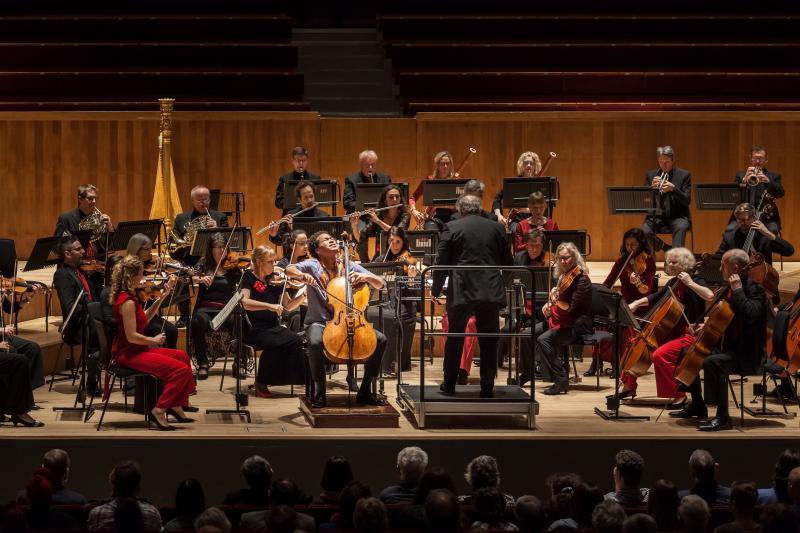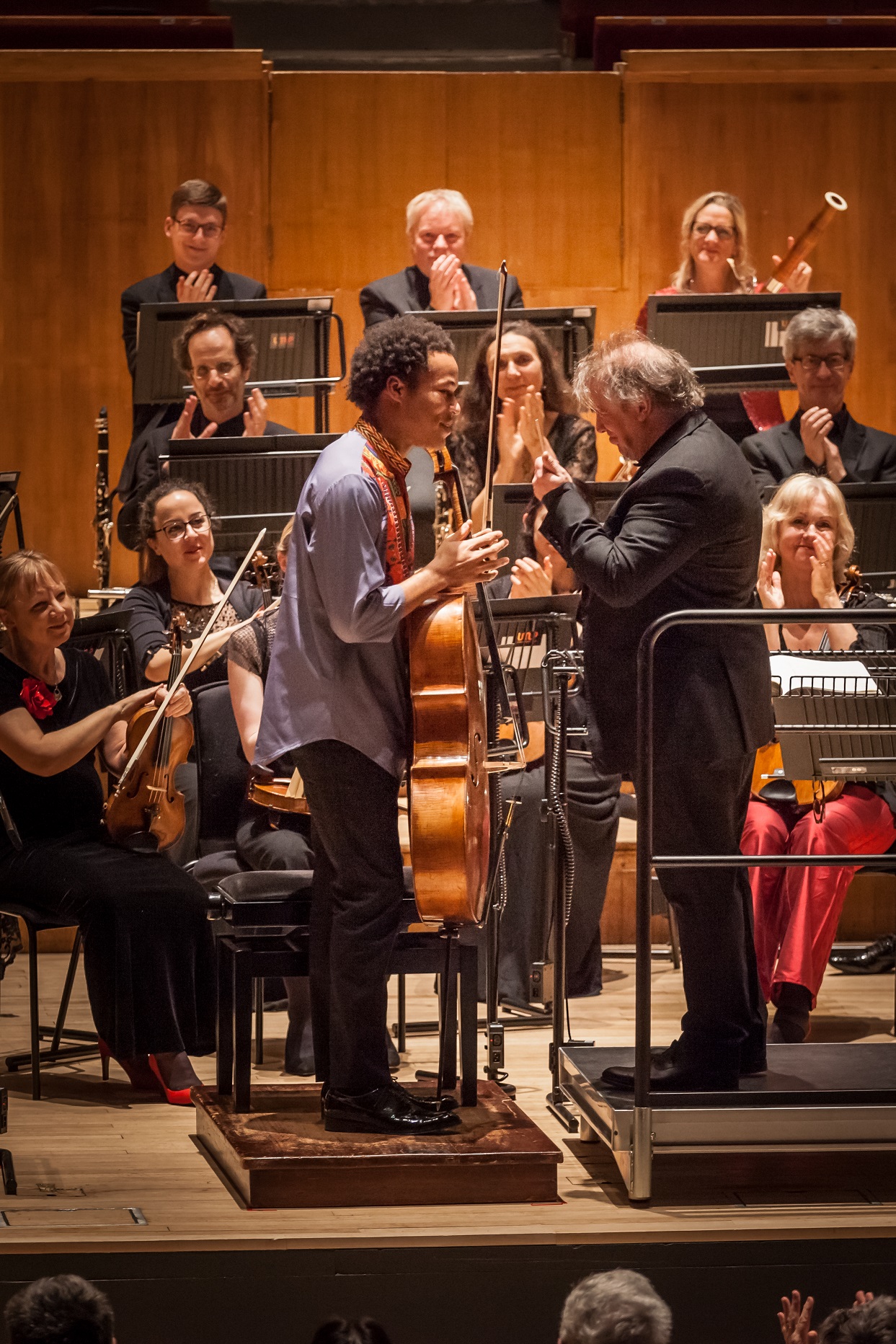Kanneh-Mason, LMP, Martín, Fairfield Halls review – modest mastery on show | reviews, news & interviews
Kanneh-Mason, LMP, Martín, Fairfield Halls review – modest mastery on show
Kanneh-Mason, LMP, Martín, Fairfield Halls review – modest mastery on show
French polish from the cello star of the moment

The soap-opera saga of the House of Windsor may not have been what the executive director of the London Mozart Players had in mind when she announced from the stage that Sheku Kanneh-Mason “is completely relevant for us”.
Formerly over-played and over-interpreted as a star vehicle for cellists in search of French fireworks, the Saint-Saëns deserves revival on a more intimate scale. It’s a shrewd choice for Kanneh-Mason to take on early in his career, and he has the full measure of its unconventional form – three movements in one 17-minute span – and Mendelssohnian refinement, almost too fluent for its own good. The central section’s antique minuet achieved a rare delicacy without searching for undue profundity.
 If Kanneh-Mason (pictured right with conductor Jaime Martín) didn’t quite nail the concerto’s concluding flourish, his understatement had a winning charm of its own. Full marks, too, for the encore: an ingenious arrangement of "The Swan" from Saint-Saëns’s Carnival of the Animals, subtly underscored by Sebastian Comberti at the principal cello’s desk with an accompaniment derived from the Prelude to Bach’s First Cello Suite.
If Kanneh-Mason (pictured right with conductor Jaime Martín) didn’t quite nail the concerto’s concluding flourish, his understatement had a winning charm of its own. Full marks, too, for the encore: an ingenious arrangement of "The Swan" from Saint-Saëns’s Carnival of the Animals, subtly underscored by Sebastian Comberti at the principal cello’s desk with an accompaniment derived from the Prelude to Bach’s First Cello Suite.
A child prodigy himself, Saint-Saëns took Mozart as his model, and the concert had opened with a spacious, carefree account of the “Paris” Symphony. After an interval prolonged by a signing session, during which seemingly half the audience wanted a piece of Kanneh-Mason, or at least a selfie, the fizz slightly went out of the bottle in the second half. The fade to black at the close of Ravel’s Pavane pour une infant defunte was nicely judged – responding to the minuet in the concerto with another wistful nod to gentler times – and the Symphony by Bizet popped open with promise, but this youthful masterpiece doesn’t play itself, and the Schubertian revels of the finale sagged under Jaime Martín’s heavy beat.
rating
Explore topics
Share this article
The future of Arts Journalism
You can stop theartsdesk.com closing!
We urgently need financing to survive. Our fundraising drive has thus far raised £49,000 but we need to reach £100,000 or we will be forced to close. Please contribute here: https://gofund.me/c3f6033d
And if you can forward this information to anyone who might assist, we’d be grateful.

Subscribe to theartsdesk.com
Thank you for continuing to read our work on theartsdesk.com. For unlimited access to every article in its entirety, including our archive of more than 15,000 pieces, we're asking for £5 per month or £40 per year. We feel it's a very good deal, and hope you do too.
To take a subscription now simply click here.
And if you're looking for that extra gift for a friend or family member, why not treat them to a theartsdesk.com gift subscription?
more Classical music
 Solomon, OAE, Butt, QEH review - daft Biblical whitewashing with great choruses
Even a top soprano and mezzo can’t make this Handel paean wholly convincing
Solomon, OAE, Butt, QEH review - daft Biblical whitewashing with great choruses
Even a top soprano and mezzo can’t make this Handel paean wholly convincing
 Two-Piano Gala, Kings Place review - shining constellations
London Piano Festival curators and illustrious friends entertain and enlighten
Two-Piano Gala, Kings Place review - shining constellations
London Piano Festival curators and illustrious friends entertain and enlighten
 Echo Vocal Ensemble, Latto, Union Chapel review - eclectic choral programme garlanded with dance
Beautiful singing at the heart of an imaginative and stylistically varied concert
Echo Vocal Ensemble, Latto, Union Chapel review - eclectic choral programme garlanded with dance
Beautiful singing at the heart of an imaginative and stylistically varied concert
 Scott, Irish Baroque Orchestra, Whelan, RIAM, Dublin review - towards a Mozart masterpiece
Characteristic joy and enlightenment from this team, but a valveless horn brings problems
Scott, Irish Baroque Orchestra, Whelan, RIAM, Dublin review - towards a Mozart masterpiece
Characteristic joy and enlightenment from this team, but a valveless horn brings problems
 Classical CDs: Voice flutes, flugelhorns and froth
Baroque sonatas, English orchestral music and an emotionally-charged vocal recital
Classical CDs: Voice flutes, flugelhorns and froth
Baroque sonatas, English orchestral music and an emotionally-charged vocal recital
 Kanneh-Mason, Britten Sinfonia, Shave, Milton Court - a grin and a big beaming smile
A pair of striking contemporary pieces alongside two old favourites
Kanneh-Mason, Britten Sinfonia, Shave, Milton Court - a grin and a big beaming smile
A pair of striking contemporary pieces alongside two old favourites
 theartsdesk at the New Ross Piano Festival - Finghin Collins’ musical rainbow
From revelatory Bach played with astounding maturity by a 22 year old to four-hand jazz
theartsdesk at the New Ross Piano Festival - Finghin Collins’ musical rainbow
From revelatory Bach played with astounding maturity by a 22 year old to four-hand jazz
 First Person: Manchester Camerata's Head of Artistic Planning Clara Marshall Cawley on questioning the status quo
Five days of free events with all sorts of audiences around Manchester starts tomorrow
First Person: Manchester Camerata's Head of Artistic Planning Clara Marshall Cawley on questioning the status quo
Five days of free events with all sorts of audiences around Manchester starts tomorrow
 Goldscheider, Brother Tree Sound, Kings Place review - music of hope from a young composer
Unusual combination of horn, strings and electronics makes for some intriguing listening
Goldscheider, Brother Tree Sound, Kings Place review - music of hope from a young composer
Unusual combination of horn, strings and electronics makes for some intriguing listening
 theartsdesk Q&A: composer Donghoon Shin on his new concerto for pianist Seong-Jin Cho
Classical music makes its debut at London's K-Music Festival
theartsdesk Q&A: composer Donghoon Shin on his new concerto for pianist Seong-Jin Cho
Classical music makes its debut at London's K-Music Festival

Add comment